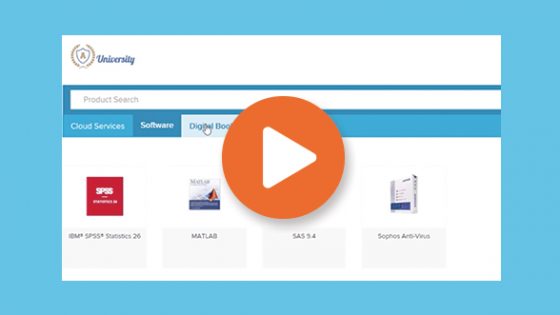The UB Tech 2019 conference was earlier this month, with representatives from the tech sector and higher education convening in Orlando, FLA. Ryan Peatt – Chief Product Officer here at Kivuto – was on site to give a presentation called Consolidate, Centralize, and Save: Strategic Licensing Approaches.
Ryan’s talk covered a lot of the pain points involved in licensing software for higher education. He identified the innovations in technology – most recently the shift to the cloud – that have contributed to how complex, costly, and risky this process has become for IT teams to manage. But it wasn’t all bad news. Schools are continuously coming up with new strategies to better manage licensing in the face of all these challenges.
Ryan also identified several core components that an ideal academic licensing strategy should incorporate, referring to recommendations made in a 2015 study by the University of Washington. Here’s a quick summary of what he had to say about three of those components: clear and sustainable licensing criteria, a central funding model, and measures to reduce risk.
Want more than a summary?
Check out Ryan’s full UB Tech 2019 presentation.
Watch The Video
Sustainable Licensing Criteria
Faculty need the freedom to choose the tools they use to teach. But when resource procurement is decentralized, there’s no visibility into what tools are being ordered, in what quantity, from which vendors, and at what price. This makes it all but impossible for institutions to optimize their budgets and ensure compliance with all laws, terms, and conditions.
The lesson here is that it’s crucial for institutions to develop enforceable and sustainable licensing criteria. This includes clear guidelines around what products their faculty can license, in what quantities, and from which vendors.
One way to accomplish this is to give faculty more visibility into what resources are available and what terms and conditions come with them. Another is to establish a request-and-approval process for faculty who want to adopt resources their school hasn’t already licensed.
The University of Utah did both. Their Office of Software Licensing set up a secure, centralized repository containing all assets available to faculty. Educators have self-serve access to all resources the school has already licensed. Requests for new assets can be submitted directly through the repository and are visible to other users who may need the same thing. By making faculty aware of what’s available and what’s been requested, and by obligating them to get approval for new resources, the university established a more efficient and less risky way for educators to select their teaching tools.
A Central Funding Model
In an ideal world, all software a school needs would be procured and funded centrally, at the enterprise level. This is the best way for institutions to ensure all compliance requirements are met and to secure the lowest prices possible.
Unfortunately, central funding models can be too rigid for many institutions. They often require that a certain level of demand for a product exist before any licenses for that product are ordered. This can result in frustrating waits for faculty and students who need resources that aren’t in high demand. Alternatively, these models may result in institutions over-ordering certain products and losing money on unused licenses.
For these reasons, schools often allow departments, or even individual faculty, to handle the procurement of their own resources. Their smaller orders rarely qualify for the best pricing, and there are risks to letting multiple parties procure licenses independently. But these are seen as necessary trade-offs for the flexibility schools need.
There are ways for schools to centralize procurement without sacrificing funds or flexibility. One option is to implement a cost-recovery plan. Queen’s University explored this possibility. Under their model, software would be procured centrally at very high volumes to get the best pricing available. The school could then ‘sell’ licenses to individual end users for far below the equivalent retail price or other volume-license / academic pricing. These chargebacks, combined with the savings the school sees by purchasing in bulk, would save Queen’s a significant amount compared to the cost of ordering licenses on an as-needed basis.
Risk Reduction
Software licensing is complex. Complexity comes with risk.
Institutions are responsible for ensuring compliance with all terms and conditions attached to every piece of software they license, from campus-wide essentials to niche products used by a single faculty member. This is already an uphill battle. As vendors transition their products to the cloud, move to time-based delivery models and inflexible clickwrap agreements (which are often updated without notice), software management and distribution will become even more complicated – and riskier.
IT teams need visibility into what software is being purchased, installed, and used at their institutions. They must ensure that the number of licenses installed never exceeds the quantity purchased. All stakeholders should clearly understand all usage rights and restrictions attached to every product they use and comply with them diligently. IT and Procurement teams need to vet service agreements against their own legal, privacy, accessibility, and computing policies, as well as applicable laws.
All of this is to say that risk reduction should be a core priority in any college or university’s software licensing strategy. Aggregated and centralized management of software licenses can help with this, by reducing the overall level of risk to schools through visibility and education.
* * * *
A clear takeaway from Ryan’s talk is that academic institutions face many challenges due to the ever-changing nature of technology affects the management and distribution of licenses in higher education. No longer can schools afford to leverage traditional models to ensure their students, faculty, and staff are equipped with the right technology to succeed. Novel and scalable new IT solutions must be developed to create the backbone for academic success and great user experiences.
Want more than a summary?
Check out Ryan’s full UB Tech 2019 presentation.
Watch The Video
More About Kivuto
For over 20 years, Kivuto has transformed the way schools distribute digital resources. Today, Kivuto streamlines the management and delivery of software, eTextbooks, and more through one central platform, providing students, faculty, and staff with a one-stop shop to access all the tools they need. Learn more here.














No Comments